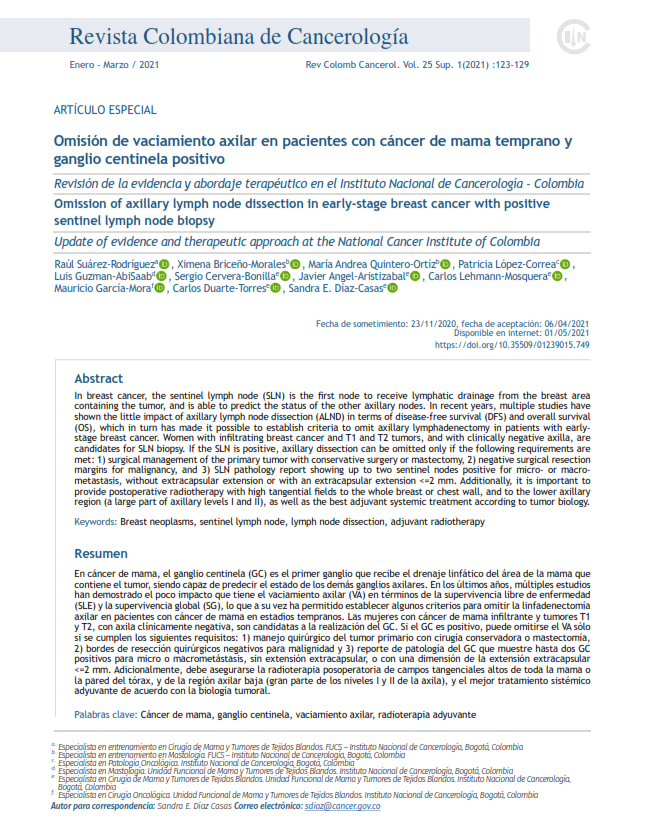Omission of axillary lymph node dissection in early-stage breast cancer with positive sentinel lymph node biopsy
Update of evidence and therapeutic approach at the National Cancer Institute of Colombia
DOI:
https://doi.org/10.35509/01239015.749Keywords:
Breast neoplasms, sentinel lymph node, lymph node dissection, adjuvant radiotherapyAbstract
In breast cancer, the sentinel lymph node (SLN) is the first node to receive lymphatic drainage from the breast area containing the tumor, and is able to predict the status of the other axillary nodes. In recent years, multiple studies have shown the little impact of axillary lymph node dissection (ALND) in terms of disease-free survival (DFS) and overall survival (OS), which in turn has made it possible to establish criteria to omit axillary lymphadenectomy in patients with earlystage breast cancer. Women with infiltrating breast cancer and T1 and T2 tumors, and with clinically negative axilla, are candidates for SLN biopsy. If the SLN is positive, axillary dissection can be omitted only if the following requirements are
met: 1) surgical management of the primary tumor with conservative surgery or mastectomy, 2) negative surgical resection
margins for malignancy, and 3) SLN pathology report showing up to two sentinel nodes positive for micro- or macrometastasis, without extracapsular extension or with an extracapsular extension <=2 mm. Additionally, it is important to provide postoperative radiotherapy with high tangential fields to the whole breast or chest wall, and to the lower axillary region (a large part of axillary levels I and II), as well as the best adjuvant systemic treatment according to tumor biology.
References
Morton DL, Wen DR, Wong JH, Economou JS, Cagle LA, Storm FK, et al. Technical Details of Intraoperative Lymphatic Mapping for Early Stage Melanoma. Arch Surg. 1992;127(4):392–9. https://doi.org/ 10.1001/archsurg.1992.01420040034005
Chung A, Giuliano AE. Lymphatic mapping and sentinel lymphadenectomy for breast cancer. Breast Compr Manag Benign Malig Dis. 2018;220(3):604-630.e6. https://doi.org/10.1097/00000658-199409000-00015
O’Hea BJ, Hill ADK, El-Shirbiny AM, Yeh SDJ, Rosen PP, Coit DG, et al. Sentinel lymph node-biopsy in breast cancer: Initial experience at memorial sloan-kettering cancer center. J AmColl Surg. 1998;186(4):423–7. https://doi.org/10.1016/s10727515(98)00060-x
Luini A, Zurrida S, Galimberti V, Intra M, Veronesi P, Robertson C, et al. 030807 A Randomized Comparison of Sentinel-Node Biopsy with Routine. Library (Lond). 2003;546–53. https://doi.org/10.1056/NEJMoa012782
Krag DN, Anderson SJ, Julian TB, Brown AM, Harlow SP, Costantino JP, et al. Sentinel-lymph-node resection compared with conventional axillary-lymph-node dissection in clinically node-negative patients with breast cancer: Overall survival findings from the NSABP B-32 randomised phase 3 trial. Lancet Oncol. 2010;11(10):927–33. https://doi.org/10.1016/S14702045(10)70207-2
Mansel RE, Fallowfield L, Kissin M, Goyal A, Newcombe RG, Dixon JM, et al. Randomized multicenter trial of sentinel node biopsy vs. standard axillary treatment in operable breast cancer: The ALMANAC trial. J Natl Cancer Inst. 2006;98(9):599–609. https://doi.org/10.1093/jnci/djj158
Giuliano AE, Hunt KK, Ballman K V., Beitsch PD, Whitworth PW, Blumencranz PW, et al. Axillary dissection vs. no axillary dissection in women with invasive breast cancer and sentinel node metastasis: A randomized clinical trial. JAMA - J Am Med Assoc. 2011;305(6):569–75. https://doi.org/10.1001/jama.2011.90
Galimberti V, Cole BF, Zurrida S, Viale G, Luini A, Veronesi P, et al. Axillary dissection vs. no axillary dissection in patients with sentinel-node micrometastases (IBCSG 23-01): A phase 3 randomised controlled trial. Lancet Oncol. 2013;14(4):297–305. https://doi.org/10.1016/S1470-2045(13)70035-4129
Donker M, van Tienhoven G, Straver ME, Meijnen P, van de Velde CJH, Mansel RE, et al. Radiotherapy or surgery of the axilla after a positive sentinel node in breast cancer (EORTC 1098122023 AMAROS): A randomised, multicentre, open-label, phase 3 non-inferiority trial. Lancet Oncol. 2014;15(12):1303–10. https://doi.org/10.1016/S1470-2045(14)70460-7
Giuliano A, Connolly J, Edge S, et al. Breast Cancer-Major changes in the American Joint Committee on Cancer eighth edition cancer staging manual. CA Cancer J Clin. 2017 Jul 8;67(4):290-303. https://doi.org/10.3322/caac.21393
Park K, Caudle A. Management of the Axilla in the Patient with Breast Cancer. Surg Clin N Am. 2018. https://doi.org/10.3322/caac.21393
NCCN Clinical Practice Guidelines in Oncology. Breast Cancer. 2020. https://doi.org/10.6004/jnccn.2020.0016
Gooch J, King T, Eaton A, et al. The Extent of Extracapsular Extension May Influence the Need for Axillary Lymph Node Dissection in Patients with T1-T2 Breast Cancer. Ann Surg Oncol. 2014 September; 21(9): 2897–2903. https://doi.org/10.1245/s10434-014-3752-0
Choi A, Blount S, Perez M, et al. Size of Extranodal Extension on Sentinel Lymph Node Dissection in the American College of Surgeons Oncology Group Z0011 Trial Era. JAMA Surg. 2015;150(12):1141-1148. https://doi.org/10.1001/jamasurg.2015.1687
Barrio A, Downs-Canner S, Edelweiss M, et al. Microscopic Extracapsular Extension in Sentinel Lymph Nodes Does Not Mandate Axillary Dissection in Z0011-Eligible Patients. Ann Surg Oncol. 2019. https://doi.org/10.1245/s10434-019-08104-1
Mamtani A, Barrio A, Goldman D, et al. Extranodal Tumor Deposits in the Axillary Fat Indicate the Need for Axillary Dissection Among T1–T2cN0 Patients with Positive Sentinel Nodes. Ann Surg Oncol. 2020. https://doi.org/10.1245/s10434020-08632-1
Guía de Práctica Clínica (GPC) para la detección temprana, tratamiento integral, seguimiento y rehabilitación de pacientes con cáncer de mama. Sistema de Seguridad Social, Colombia, 2013. Guía No. 19.
How to Cite
Downloads

Downloads
Published
Issue
Section
License
Todos los derechos reservados.




